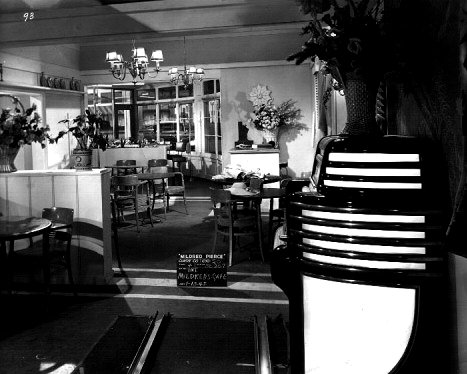Anton Grots

One of my first job’s was with Anton Grot’s it was on the film set of Mildred Pierce, as a set stills photographer, I would take still shots of the film set construction as it went up, built on the film set at the old Warner Bros. Studio backlot on Sunset Boulevard.
When producer Jerry Wald read Mildred Pierce shortly after it was published in 1941, he knew it could make a good movie. He also knew it would be an uphill battle to turn it into a screenplay that would be acceptable by Production Code standards. Mildred’s divorce, her fling with a charming playboy, her daughter’s sexual escapades were just a few items that would be troubling for censors. And possibly more troubling than all the rest would be the fact that the author, James M. Cain, tells Mildred’s story without moralizing. He does not condemn her. He merely follows Mildred’s progress, presenting a detailed and convincing portrait of a woman fighting for success, while also exploring the reasons for her ambition.
The Production Code demanded that Hollywood films adhere to strictly defined standards of morality. So to satisfy the censors, Wald injected a murder into the story, and reshaped the ending to assure the audience that justice was served. According to Thomas Schatz’s book The Genius of the System, the producer struggled long and hard with the script. In order to achieve the right tone for a “woman’s” picture, he first assigned Catherine Turney to the project. But to get the tension he needed for a thriller, he had Albert Maltz work Turney’s material over. Other writers also took a shot at the script, but Ranald MacDougall received sole credit for his extensive work on the final version.
The film was directed with smooth precision by Michael Curtiz. By this point in his career Curtiz had refined his approach to the point where his films had a fluid, compelling visual style. He often follows the characters with his camera, using long takes and careful lighting to define space and create atmosphere. On Mildred Pierce he was aided by art director Anton Grot, who had worked on many films with the director. Cinematographer Ernest Haller also played an important part, giving the film the gloss the studio demanded, but still doing justice to the story’s grittier aspects.
The movie is also interesting for the way it portrays Los Angeles in the mid-forties. Cain had written the book as the Depression was ending, and his portrait of the city makes vivid the bitterness and despair of those times. Since Curtiz and his collaborators were shooting the movie a few years later, they captured a different Los Angeles. Granted, the studio would certainly not have allowed them to dwell too much on the city’s seamier side, but the war brought the economy roaring back to life and the film reflects the vitality that was in the air. Curtiz gives us a fascinating, if skewed, picture of Los Angeles as WWII was winding down. Customers eat in their cars in the drive-in dining area at Mildred’s restaurant. Sailors whistle at Veda as she sings at a seedy dive on the Santa Monica pier. Monty shows Mildred his house at the beach, revealing an interesting mix of rustic and modern.
Joan Crawford is excellent as Mildred, and the supporting cast is amazing. Jack Carson combines his usual energy with overbearing arrogance to make the lawyer/hustler Wally thoroughly repulsive. Eve Arden’s impeccable sense of timing and inflection make Ida a joy to watch. Zachary Scott is both seductive and appalling as Monte. And just as impressive as all these seasoned pros is the young Ann Blyth, who gives a chilling performance as Veda.
Cain’s novel is unsparing in its depiction of the characters, while the movie tends to smooth away the scarier edges. This wasn’t just the Production Code. A star like Joan Crawford would probably not want to play a character if it meant crossing certain boundaries. Even if they did, the studio would probably not allow them to play a part that might damage their image. In the film Mildred may be weak, may be fearful, but she is never pathetic or awkward as she was in Cain’s book. When Mildred looks for work in the movie, her voiceover narration accompanies a quick montage in which she rises to the challenge. In the book we accompany Mildred as she learns how difficult and humiliating it can be to work for a living. In the movie Mildred shows her anger at Veda with a sharp slap. In the book’s climax, Mildred is so consumed with anger she tries to strangle her own daughter. Most tellingly, in the final scenes of the movie Mildred acknowledges her mistake in divorcing Bert and they walk off together as the music swells. The book ends with the two of them clinging to each other in the depths of despair.
Join FREE & Launch Your Business!
Exclusive Bonus - Offer Ends at Midnight Today
00
Hours
:
00
Minutes
:
00
Seconds
2,000 AI Credits Worth $10 USD
Build a Logo + Website That Attracts Customers
400 Credits
Discover Hot Niches with AI Market Research
100 Credits
Create SEO Content That Ranks & Converts
800 Credits
Find Affiliate Offers Up to $500/Sale
10 Credits
Access a Community of 2.9M+ Members
Recent Comments
1
Join FREE & Launch Your Business!
Exclusive Bonus - Offer Ends at Midnight Today
00
Hours
:
00
Minutes
:
00
Seconds
2,000 AI Credits Worth $10 USD
Build a Logo + Website That Attracts Customers
400 Credits
Discover Hot Niches with AI Market Research
100 Credits
Create SEO Content That Ranks & Converts
800 Credits
Find Affiliate Offers Up to $500/Sale
10 Credits
Access a Community of 2.9M+ Members
I have heard of it but never seen/read. Jian is great though - love baby Jane! Must look into further. :)